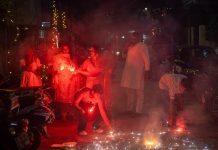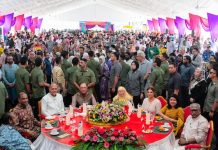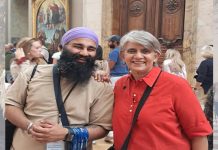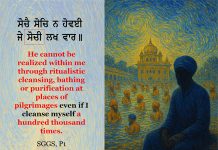
By Dr. Charanjit Kaur | Opinion |
Sikhs are a double minority in most parts of the diaspora, including Malaysia. As an ethnic and religious minority, Sikhs face unique challenges shaped by the social and policy environment of their host countries. Interestingly, in Malaysia, the government has long recognized Sikhs as a distinct and respected community, never conflating their faith with other Indian sub-ethnic groups. This recognition is also reflected in national school textbooks, which portray Sikh identity clearly and respectfully without generalizing them under the broader Indian category.
As an academic and interfaith speaker, I recently felt prompted to share a few thoughts following an article published on 20 October 2025 by the New Straits Times, titled “Anwar, Wife Visit Gobind’s Home for Deepavali”. The article generated many public comments, some expressing genuine confusion over when Sikhs began celebrating Deepavali. Yet, I was heartened to see that many Malaysians especially non-Indians recognized Sikhs as a distinct faith community and sought sincere clarification.
This essay therefore aims to address the matter in the spirit of understanding and dialogue, not division. It should be noted that many thoughtful articles have already explored the relationship between Sikhs and Diwali. Yet, the reception and interpretation of these writings remain subjective, often influenced by readers’ comfort levels or preexisting beliefs. What I find most intriguing, however, is that much of the confusion arises not from non-Sikhs but from Sikhs themselves, both in Malaysia and globally.
SEE ALSO: Diwali and Sikhi
SEE ALSO: When Diwali Became Deepavali: From Ritual to Reverence
SEE ALSO: Diwali: To celebrate or not to?
Many justify their participation in Diwali celebrations by referring to Bandi Chhor Divas, which commemorates the release of Guru Hargobind Sahib Ji, the sixth Sikh Guru from imprisonment. While this historical moment holds emotional resonance, most stop at this surface connection without examining its spiritual, historical or logical foundations.Several Sikh thinkers around the world have already explored these dimensions in detail; therefore, my intention here is not to repeat their work. Instead, I wish to explain the issue in a non-academic and accessible manner so that non-Sikh readers can also understand the distinctions between the major Indian festivals observed in Malaysia.
The Sikh View of Light: From Ritual to Revelation
Sikhs are known as a textual community, grounded in the Guru Granth Sahib, a sacred scripture of 1,430 pages, revered as the Living Guru and the enduring guide for spiritual insight and ethical living. The Guru Granth Sahib is not a record of rituals but a universal revelation of spiritual truth. Its teachings form the exclusive foundation of Sikh philosophy and practice. Yet, despite this textual centrality, many Sikhs today are not well-versed in reading or interpreting the Guru Granth Sahib. Many approach the scripture at a surface level, focusing on literal words and assuming that the presence of a term in the text equates to divine endorsement of the act or idea it describes. This literalism has given rise to multiple misconceptions about concepts such as rebirth, karma, patriarchal systems, heaven and hell and nuanced ideas like maya, mukti, naam, hukam, egoand simran.
Likewise, the mere mention of Diwali in Sikh literature is sometimes taken as a sign of divine approval even though the verse in question carries a metaphoric message not a ritual instruction. This misunderstanding arises mainly from Bhai Gurdas Ji’s Vaar 19, Pauri 6, where Diwali is mentioned. Many preachers have chosen to interpret and perform this verse as an endorsement of Diwali observance particularly the lighting of lamps as if it were an authentic Sikh tradition. However, this interpretation overlooks the interpretive methodology intrinsic to Sikh scripture.
The verses of the Guru Granth Sahib are highly sophisticated in poetic and philosophical form, often referencing the social and cultural practices of their time merely as illustrative tools. The true message (the spiritual essence) resides in the Rahao line, which conveys the heart of the Shabad. In the case of Bhai Gurdas Ji’s Vaars, where the Rahao is absent, the essence is revealed in the concluding line of the verse. Readers familiar with poetry and classical literature will recognize that such structures demand careful reading for their meaning unfolds not in literal expression but in layered metaphor and symbolism.
The verse reads:
ਦੀਵਾਲੀ ਦੀ ਰਾਤਿ ਦੀਵੇ ਬਾਲੀਅਨਿ।
ਤਾਰੇ ਜਾਤਿ ਸਨਾਤਿ ਅੰਬਰਿ ਭਾਲੀਅਨਿ।
ਫੁਲਾਂ ਦੀ ਬਾਗਾਤਿ ਚੁਣਿ ਚੁਣਿ ਚਾਲੀਅਨਿ।
ਤੀਰਥਿ ਜਾਤੀ ਜਾਤਿ ਨੈਣ ਨਿਹਾਲੀਅਨਿ।
ਹਰਿਚੰਦਉਰੀ ਝਾਤਿ ਵਸਾਇ ਉਚਾਲੀਅਨਿ।
ਗੁਰਮੁਖਿ ਸੁਖ ਫਲ ਦਾਤਿ ਸਬਦਿ ਸਮ੍ਹਾਲੀਅਨਿ ॥੬॥
Diwali Dee Rat Deevay Baleean.
Tarey Jaat Snaat Ambar Bhaleean.
Fullan Dee Bagaat, Chun Chun Chaleean.
Teerath Jatee Jaat Nain Nihalean hir
Har Chandauree Jhaat Vasae Uchaleean
Gurmukh Sukh Fal Dat Shabad Smaleean. [6]
The lamps of the night of Diwali eventually burn out.
The stars of the night sky stop sparkling when dawn comes.
The beauty of the orchard disappears as the flowers are picked.
The gaiety of the place of pilgrimage dies when the crowds leave.
Life even as bestowed by God is temporary; settled and then destructed.
Yet, the Gurmukh is blessed with the fruit of permanent joy through his Immersion in the Shabad.
Far from glorifying Diwali, Bhai Gurdas Ji uses these images to highlight impermanence, the temporary nature of worldly lights, pleasures and gatherings. The deeper message lies in the final line: true joy and light are found not in candles or festivities but in the Shabad, the Divine Word that awakens the soul. While our Hindu and Jain friends celebrate Diwali as the triumph of light over darkness, good over evil and knowledge over ignorance, the Sikh path redirects the focus inward from external illumination to inner enlightenment. The Gurmukh, one who lives by the Guru’s guidance, experiences enduring bliss not through rituals or possessions but through profound connection with the Divine. The joy that flows from immersion in Shabad is eternal unlike the flickering lamps of Diwali night, the fading stars or the temporary celebrations of festivals and pilgrimages.

This single poetic reference out of more than 5,871 verses hardly establishes Diwali as a Sikh festival. To assume that every word mentioned in the scripture implies a prescriptive practice is both simplistic and spiritually limiting. By that logic, one would also be obliged to adopt practices like sati, purdah, maya or attachment; all of which appear in the text but only as critiques of human delusion not endorsements. In short, Sikh scripture uses cultural metaphors of its time to convey timeless truths; to read them literally is to miss their essence.
Bandee Chor Divas: Selective Memory
Another source of confusion arises from the historical incident known as Bandee Chor Divas, literally translated as ‘the Day of Prisoners’ Release’. It commemorates Guru Hargobind Sahib Ji’s release from Gwalior Fort, where he secured freedom not only for himself but for 52 other kings. The event beautifully symbolizes freedom, compassion and justice, virtues deeply embedded in Sikh teaching.
Yet, two reflections are worth considering.
First, why does the community emphasize this particular episode while seldom remembering similar moments of liberation by other Gurus such as Guru Harkrishan Ji’s release or Guru Nanak Sahib Ji’s freedom from Babur’s prison more than a century earlier? Furthermore, if liberation is the central theme, why is the focus restricted only to a single episode of physical release rather than on the broader spiritual liberation and the victories of truth and justice that the Gurus embodied throughout their lives? Such selective reverence invites reflection on whether our devotion today aligns with the original spirit of Gurmat or has become shaped by cultural repetition.
Second, there is a tendency to overlook the logical inconsistency in how the date of Bandee Chor Divas changes every year. Unlike fixed Sikh commemorations such as Nanakshahi New Year (14 March) or Vaisakhi (14 April), this occasion shifts annually; for example 4 Nov 2021, 24 Oct 2022, 12 Nov 2023, 31 Oct 2024, and 20 Oct 2025. Some may explain this variation by citing the traditional lunar calendar but if we adhere strictly to historical accuracy, Guru Hargobind Sahib Ji’s arrival in Amritsar actually occurred on 12 February. This raises an honest question: Why continue linking this commemoration to Diwali’s lunar date rather than to its historically recorded day?
Such inquiries are not meant to dismiss devotion but to deepen understanding. Critical reflection, the courage to think, to ask and to seek alignment between faith and fact appears increasingly rare within our community. Too often, we accept inherited narratives without contemplation or study. The dialogue surrounding the meanings of Gurbani remains confined to a few scholars and spiritually curious individuals while the wider audience tends to embrace practice over principle. To return to the essence of Sikh spirituality, we must revive this culture of critical inquiry grounded in humility where faith and intellect walk together and reverence does not silence reflection.
Diwali in Malaysian Sikh Homes
Over time, the boundaries between cultural belonging and spiritual conviction have become increasingly blurred within the Sikh diaspora. Living among larger South Asian communities, Sikhs often find themselves participating in festivals such as Diwali, Holi or Raksha Bandhan, not always out of theological belief but out of social courtesy, nostalgia or cultural pressure. In many contexts, these acts are expressions of harmony and community rather than worship. Yet, when repeated uncritically, they risk reshaping the very spiritual identity that Guru Nanak envisioned as distinct from ritualism and caste-based religiosity.
FOR MORE ARTICLES ON DIWALI, CLICK HERE
This phenomenon can be understood as a form of cultural imitation where symbols of belonging override the pursuit of spiritual clarity. The intention may be good to maintain social cohesion or avoid conflict but the outcome is subtle assimilation into the very ritual culture that Sikh thought originally sought to transcend. Guru Nanak’s revolution was not merely religious but epistemological, it redefined how human beings relate to the Divine: through inner realization, ethical living and remembrance of Naam, not through ritual repetition.

The Sikh experience as a minority in Malaysia is not as fraught as it once was in Punjab, where movements like the Singh Sabha had to assert their distinct identity through the declaration “Hum Hindu Nahin” (We are not Hindus). In Malaysia, earlier generations of Sikhs especially during the post-independence years possessed a clear understanding of the Guru Granth Sahiband lived their daily lives according to Sikh teachings. Consequently, Sikhs in those decades did not celebrate Diwali (or Deepavali), recognizing it as a Hindu festival unrelated to Sikhi. In fact, during the 1984 attacks on Sikhs in India, the Malaysian Sikh community took a principled and courageous stance to reinforce Sikh identity. Their collective efforts contributed to the Malaysian government’s formal recognition of Sikhi as a separate religious entity, the growing prominence of Vaisakhi as the primary Sikh celebration and a conscious refusal to celebrate Diwali as a religious occasion.
Over time, however, as Sikhs became more integrated into Malaysia’s multicultural fabric, social adaptation began to influence community practices. By the 1980s and 1990s, many Sikhs observed Diwali more as a social or community gathering than as a spiritual or religious observance. Families would visit the gurdwara in the morning and later host open houses for friends and neighbors. Vaisakhi, at that point, was still perceived primarily as a religious function, while Diwali being a national public holiday for Indians naturally became an opportunity for social connection and goodwill. In this sense, Diwali for some Sikhs became an expression not of devotion but of social harmony, a gesture of friendship rather than faith. This is not unique to Malaysia: many Sikhs in Western societies similarly participate in Christmas, Thanksgiving or New Year celebrations, not as religious rituals but as acts of social belonging.
In Malaysian homes, Diwali is often marked by the preparation of Punjabi sweets such as methiyan, sekarparay, and pakorianalong with local delicacies like murukku and ghee balls shared warmly with neighbors of all faiths. In turn, Sikhs receive festive foods during Hari Raya or Chinese New Year. Yet, over the years, some of these gatherings have begun to incorporate elements inconsistent with Sikh discipline including alcohol consumption, blurring the boundary between cultural courtesy and spiritual compromise.
So, is celebrating Diwali inherently ‘wrong’?
Not exactly. Sharing food, fostering friendship and welcoming neighbors are not objectionable. What is critical, however, is clarity of intent and an accurate understanding of Sikh identity. Sikhs may participate socially without endorsing it as a religious practice provided they represent their faith truthfully. Moreover, such open-house hospitality need not be confined to cultural calendars; it can be expressed at any time, reinforcing community bonds without compromising spiritual integrity.
Personally, I have spent over two years educating my social circles about this distinction. I always appreciate Deepavali greetings but I also respond with gentle clarification, for example: “Thank you for your kind wishes. I truly appreciate them. However, as Sikhs, we don’t celebrate Deepavali or Diwali — our main celebration is on April 14 each year, known as Vaisakhi Day. Enjoy the holidays!” The impact has been heartening. Today, my non-Sikh friends no longer send Diwali wishes, instead, they message me every April with “Khalsa Day” greetings. In fact, my interfaith colleagues understand this distinction better than many Sikhs themselves. This, I believe, is the power of sharing accurate information respectfully; not to divide but to enlighten.
Reclaiming the Light Within
Under the subtle influence of Brahmanical ritual culture and Bollywood popularization, many Sikhs today find themselves participating in festivals such as Lohri, Maghi, Rakhi, Shraad, Sangrand, Maasiya, Puranmashi, Karva Chauth, Dussehra, Diwali and Holi, often justifying them as cultural expressions. Yet this trend gently distances the community from its foundational spiritual identity: one grounded not in external rituals or seasonal festivities but in the lived experience of the Shabad Guru, the Light that never fades.
In conclusion, attempts to reinterpret Diwali within Sikh philosophy or to incorporate it into gurdwara practices often stem from good intentions but risk confusing cultural adaptation with spiritual authenticity. The Guru’s message does not condemn others’ traditions but it calls Sikhs to remain grounded in their own. True light, for a Sikh is not the flicker of a lamp but the illumination of consciousness that arises from the Shabad Guru. The real celebration is not bound to a date or ritual but to a living awareness of truth, humility and compassion. In Malaysia’s multicultural society, the best way to honor both Sikh faith and national harmony is simple: to live and share our beliefs with clarity, respect and kindness by letting our light shine not through lamps or fireworks but through truthful living, selfless service and remembrance of the One Light that shines in all.
(Check the comments for the article at Asia Samachar Facebook and Instagram)

Associate Professor Dr. Charanjit Kaur is an expert in cultural anthropology, with a special focus on the Sikh minority community in Malaysia. Her work explores themes such as religious-cultural conflict, gender identity, and social behavior.
RELATED STORY:
Young Sikhs, Old Beliefs: Changing Views on LGBT (Asia Samachar, 21 June 2025)
ASIA SAMACHAR is an online newspaper for Sikhs / Punjabis in Southeast Asia and beyond. You can leave your comments at our website, Facebook, Twitter, and Instagram. We will delete comments we deem offensive or potentially libelous. You can reach us via WhatsApp +6017-335-1399 or email: asia.samachar@gmail.com. For obituary announcements, click here































